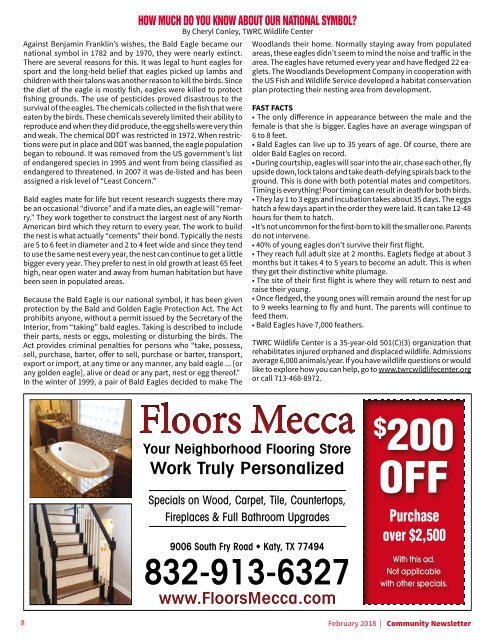Williamsburg Settlement February 2018
You also want an ePaper? Increase the reach of your titles
YUMPU automatically turns print PDFs into web optimized ePapers that Google loves.
Against Benjamin Franklin’s wishes, the Bald Eagle became our<br />
national symbol in 1782 and by 1970, they were nearly extinct.<br />
There are several reasons for this. It was legal to hunt eagles for<br />
sport and the long-held belief that eagles picked up lambs and<br />
children with their talons was another reason to kill the birds. Since<br />
the diet of the eagle is mostly fish, eagles were killed to protect<br />
fishing grounds. The use of pesticides proved disastrous to the<br />
survival of the eagles. The chemicals collected in the fish that were<br />
eaten by the birds. These chemicals severely limited their ability to<br />
reproduce and when they did produce, the egg shells were very thin<br />
and weak. The chemical DDT was restricted in 1972. When restrictions<br />
were put in place and DDT was banned, the eagle population<br />
began to rebound. It was removed from the US government’s list<br />
of endangered species in 1995 and went from being classified as<br />
endangered to threatened. In 2007 it was de-listed and has been<br />
assigned a risk level of “Least Concern.”<br />
Bald eagles mate for life but recent research suggests there may<br />
be an occasional “divorce” and if a mate dies, an eagle will “remarry.”<br />
They work together to construct the largest nest of any North<br />
American bird which they return to every year. The work to build<br />
the nest is what actually “cements” their bond. Typically the nests<br />
are 5 to 6 feet in diameter and 2 to 4 feet wide and since they tend<br />
to use the same nest every year, the nest can continue to get a little<br />
bigger every year. They prefer to nest in old growth at least 65 feet<br />
high, near open water and away from human habitation but have<br />
been seen in populated areas.<br />
Because the Bald Eagle is our national symbol, it has been given<br />
protection by the Bald and Golden Eagle Protection Act. The Act<br />
prohibits anyone, without a permit issued by the Secretary of the<br />
Interior, from “taking” bald eagles. Taking is described to include<br />
their parts, nests or eggs, molesting or disturbing the birds. The<br />
Act provides criminal penalties for persons who “take, possess,<br />
sell, purchase, barter, offer to sell, purchase or barter, transport,<br />
export or import, at any time or any manner, any bald eagle ... [or<br />
any golden eagle], alive or dead or any part, nest or egg thereof.”<br />
In the winter of 1999, a pair of Bald Eagles decided to make The<br />
HOW MUCH DO YOU KNOW ABOUT OUR NATIONAL SYMBOL?<br />
By Cheryl Conley, TWRC Wildlife Center<br />
Woodlands their home. Normally staying away from populated<br />
areas, these eagles didn’t seem to mind the noise and traffic in the<br />
area. The eagles have returned every year and have fledged 22 eaglets.<br />
The Woodlands Development Company in cooperation with<br />
the US Fish and Wildlife Service developed a habitat conservation<br />
plan protecting their nesting area from development.<br />
FAST FACTS<br />
• The only difference in appearance between the male and the<br />
female is that she is bigger. Eagles have an average wingspan of<br />
6 to 8 feet.<br />
• Bald Eagles can live up to 35 years of age. Of course, there are<br />
older Bald Eagles on record.<br />
• During courtship, eagles will soar into the air, chase each other, fly<br />
upside down, lock talons and take death-defying spirals back to the<br />
ground. This is done with both potential mates and competitors.<br />
Timing is everything! Poor timing can result in death for both birds.<br />
• They lay 1 to 3 eggs and incubation takes about 35 days. The eggs<br />
hatch a few days apart in the order they were laid. It can take 12-48<br />
hours for them to hatch.<br />
• It’s not uncommon for the first-born to kill the smaller one. Parents<br />
do not intervene.<br />
• 40% of young eagles don’t survive their first flight.<br />
• They reach full adult size at 2 months. Eaglets fledge at about 3<br />
months but it takes 4 to 5 years to become an adult. This is when<br />
they get their distinctive white plumage.<br />
• The site of their first flight is where they will return to nest and<br />
raise their young.<br />
• Once fledged, the young ones will remain around the nest for up<br />
to 9 weeks learning to fly and hunt. The parents will continue to<br />
feed them.<br />
• Bald Eagles have 7,000 feathers.<br />
TWRC Wildlife Center is a 35-year-old 501(C)(3) organization that<br />
rehabilitates injured orphaned and displaced wildlife. Admissions<br />
average 6,000 animals/year. If you have wildlife questions or would<br />
like to explore how you can help, go to www.twrcwildlifecenter.org<br />
or call 713-468-8972.<br />
Floors Mecca<br />
Your Neighborhood Flooring Store<br />
Work Truly Personalized<br />
Specials on Wood, Carpet, Tile, Countertops,<br />
Fireplaces & Full Bathroom Upgrades<br />
9006 South Fry Road • Katy, TX 77494<br />
832-913-6327<br />
www.FloorsMecca.com<br />
$<br />
200<br />
OFF<br />
Purchase<br />
over $2,500<br />
With this ad.<br />
Not applicable<br />
with other specials.<br />
8 <strong>February</strong> <strong>2018</strong> | Community Newsletter

















